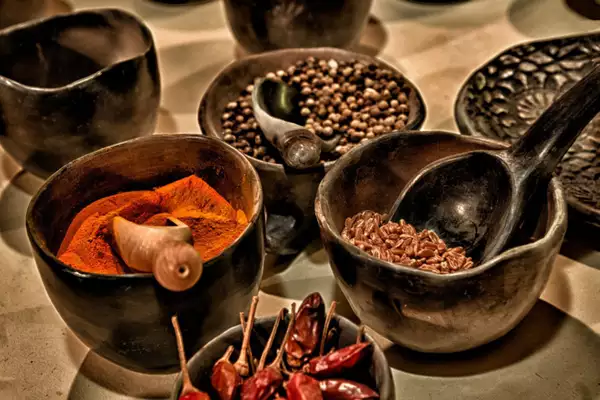The Spices Board under the Ministry of Commerce and Industry has launched the SPICED Scheme, aimed at enhancing spice exports, improving cardamom productivity, and upgrading post-harvest spice quality across India.
- The scheme will be implemented during the 15th Finance Commission cycle (2023-24 to 2025-26) with a total outlay of ₹422.30 crore.
Key Objectives of the SPICED Scheme
- Enhance export of spices and value-added spice products.
- Boost productivity of cardamom (small and large).
- Upgrade post–harvest quality for export.
- Build capacity and enhance skill development for stakeholders.
Major Components of the Scheme:
- Mission Value Addition: Focuses on enhancing the value-added spice products.
- Mission Clean and Safe Spices: Aims to improve post-harvest processes and ensure food safety standards.
- Spice Incubation Centres: Supports entrepreneurship and innovation in the spice sector.
- Productivity Improvement: Enhancing the production of spices, especially cardamom.
- Post-Harvest Quality Upgradation: Focus on improving the quality of spices post-harvest to meet export standards.
- Market Expansion and Trade Promotion: Strengthening the market presence of Indian spices domestically and internationally.
- Technology Interventions: Adoption of advanced technologies to enhance spice production and processing.
- Research and Capacity Building: Promoting research in spice production and building the capacity of stakeholders.
- Skill Development: Developing the skills of farmers, entrepreneurs, and other stakeholders involved in the spice sector.
- Promotion of GI-tagged Spices: Facilitates the promotion of spices with Geographical Indication (GI) status.
Focus Groups and Beneficiaries
- Farmer Producer Organizations (FPOs) and Clusters: Prioritized for productivity and quality upgradation.
- SC/ST Communities and SMEs: Special focus on small and medium enterprises, especially from the Northeast.
- ODOP and DEH Farmers: Farmers identified under One District One Product (ODOP) and District Export Hub (DEH).
Key Programs under SPICED Scheme
- Cardamom Productivity Enhancement:
- Replanting initiatives.
- Production of quality planting materials.
- Micro-irrigation and water source development.
- Weather-based insurance for farmers.
- Post-Harvest Quality Upgradation:
- Initiatives under Mission Clean and Safe Spices.
- Sustainable production and certification systems.
- Value Addition and Technological Interventions:
- Support for processing, market expansion, product development, and branding.
- In-house laboratory upgradation for quality assurance.
- Trade Promotion:
- Participation in international fairs and buyer-seller meets.
- Promotion of GI-tagged spices in domestic and global markets.
- Financial Assistance for SMEs and First-time Exporters: Assistance for setting up Spice Incubation Centres.
About Cardamom Cultivation
- Small Cardamom:
- Native: Indigenous to the evergreen forests of the Western Ghats of South India.
- Major Producers: Kerala, Karnataka, and Tamil Nadu.
- Favorable Conditions:
- Grows best in thick shady areas with loamy soil, which is generally acidic.
- Optimal elevation: 600 to 1500 meters.
- Requires adequate drainage for growth.
- Large Cardamom:
- Distribution: Found in the Sub-Himalayan region of Northeast India, Nepal, and Bhutan.
- Favorable Conditions:
- Requires 3000-3500 mm of rainfall spread over 200 days.
- Thrives in temperatures ranging from 6°C to 30°C.
About Spices Board India
- Role: Responsible for promoting the export of 52 scheduled spices and developing cardamom (small and large).
- Constituted in: 1987 under the Spices Board Act 1986.
- Headquarters: Cochin, Kerala.
- Ministry: Ministry of Commerce and Industry.
Ref: Source
| UPSC IAS Preparation Resources | |
| Current Affairs Analysis | Topperspedia |
| GS Shots | Simply Explained |
| Daily Flash Cards | Daily Quiz |
Frequently Asked Question:
What is the SPICED Scheme?
The SPICED Scheme is an initiative by the Spices Board to enhance spice exports, improve cardamom productivity, and upgrade post-harvest quality.
What is the total outlay for the SPICED Scheme?
The SPICED Scheme has a total outlay of ₹422.30 crore and will be implemented during the 15th Finance Commission cycle.
Which spices does the SPICED Scheme focus on improving productivity?
The scheme focuses on boosting the productivity of small and large cardamom, among other spices.
What are the major components of the SPICED Scheme?
Key components include value addition, post-harvest quality upgradation, productivity improvement, market expansion, and promoting GI-tagged spices.
Who are the main beneficiaries of the SPICED Scheme?
The scheme prioritizes Farmer Producer Organizations (FPOs), SC/ST communities, SMEs, and farmers under the One District One Product (ODOP) initiative.




